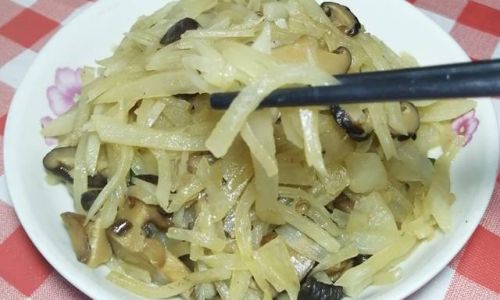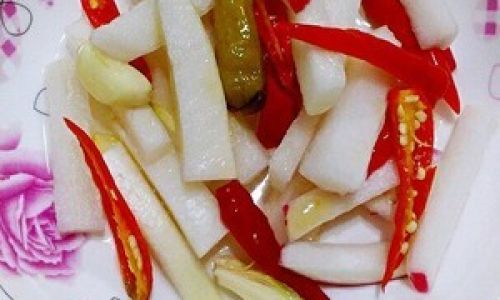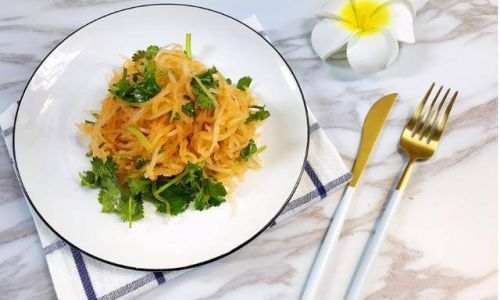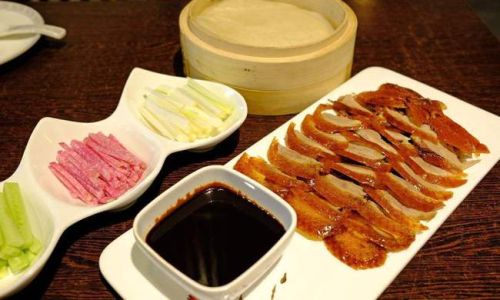Introduction
Stir-fried daikon radish, a humble yet versatile vegetable, is a staple in many Asian cuisines. Known for its crisp texture and mild, slightly sweet flavor, daikon radish (also called white radish or mooli) transforms into a delightful dish when cooked properly. While it may seem simple, achieving the perfect balance of tenderness and crunch requires attention to detail. This article will explore the techniques, ingredients, and tips needed to elevate your stir-fried daikon radish from ordinary to extraordinary. Whether you’re a seasoned home cook or a novice in the kitchen, this guide will help you master this underrated vegetable.
Selecting the Right Daikon Radish
The foundation of a great stir-fry begins with choosing the freshest daikon radish. Look for firm, unblemished roots with smooth, glossy skin. Avoid specimens with soft spots, wrinkles, or excessive sprouting, as these indicate age or improper storage. Size matters too: medium-sized daikons (around 8–10 inches long) tend to be sweeter and less fibrous than their larger counterparts. The color should be bright white, with vibrant green leaves still attached if possible—a sign of recent harvest.
When purchasing, consider the texture you aim to achieve. Younger daikons have a crisper, juicier flesh, ideal for stir-fries, while older ones may develop a spicier kick and softer consistency. If unsure, ask your grocer for recommendations or opt for organic varieties, which often boast superior flavor.

Preparation Techniques: Unlocking Texture and Flavor
Proper preparation is key to enhancing daikon’s natural qualities. Start by peeling the radish with a sharp knife or vegetable peeler, removing the tough outer layer to expose the tender flesh beneath. Rinse it under cold water to eliminate any dirt or residual grit.
Next, slice the daikon into uniform pieces to ensure even cooking. Thin matchsticks (about 2–3 inches long and ¼-inch thick) are classic for stir-fries, as they cook quickly and retain their crunch. Alternatively, half-moon slices or small cubes work well, depending on your preference. Avoid thick or irregular cuts, which can lead to unevenly cooked pieces.
Some cooks soak sliced daikon in cold water for 10–15 minutes to remove bitterness, though this step is optional. If you choose to do so, pat the pieces dry thoroughly afterward to prevent sogginess during stir-frying. For added depth, blanch the daikon in boiling water for 1–2 minutes before stir-frying—a technique that softens the fibers slightly while preserving its vibrant color.
The Science of Stir-Frying: Heat, Oil, and Timing
Stir-frying is a high-heat cooking method that relies on rapid searing to lock in flavor and texture. To achieve this, use a wok or large skillet with sloped sides, which distribute heat evenly and allow for constant tossing. Preheat the pan over medium-high heat until a drop of water sizzles and evaporates instantly. Add a neutral oil with a high smoke point, such as peanut, canola, or avocado oil, and swirl to coat the surface.

Once the oil shimmers, add aromatics like minced garlic, ginger, or sliced shallots. Sauté briefly until fragrant (15–30 seconds), then toss in the daikon. Stir vigorously to coat each piece in oil, ensuring even cooking. The goal is to caramelize the edges slightly while maintaining a crisp center—a balance achieved through constant motion and precise timing.
Flavor Pairings: Elevating Daikon’s Natural Sweetness
Daikon’s mild flavor acts as a canvas for bold seasonings. Classic combinations include soy sauce, oyster sauce, or a splash of rice vinegar for umami richness. For a touch of heat, add chili flakes, fresh bird’s eye chilies, or a dollop of spicy bean paste.
Consider regional variations for inspiration. In Chinese cuisine, daikon is often stir-fried with dried shrimp, fermented black beans, or Shaoxing wine. Japanese recipes might incorporate mirin, dashi, or a sprinkle of shichimi togarashi. For a vegan twist, use coconut aminos or a pinch of smoked paprika to mimic smokiness.
Balance is crucial: daikon’s inherent sweetness pairs well with acidic ingredients like lime juice or pickled ginger, which cut through richness. A final drizzle of sesame oil or garnish of toasted sesame seeds adds nutty complexity.

Mastering Texture: Crisp vs. Tender
The ideal stir-fried daikon offers a contrast of textures: slightly tender edges with a firm, almost al dente center. Avoid overcooking, which renders the radish mushy and dull. To test doneness, pierce a piece with a fork—it should meet minimal resistance but retain its shape.
For added crunch, finish the dish with a handful of julienned bell peppers, carrots, or snow peas during the last minute of cooking. These vegetables not only enhance texture but also introduce vibrant colors to the plate.
Troubleshooting Common Mistakes
Even experienced cooks stumble occasionally. Here’s how to fix issues:
- Soggy daikon: Overcrowding the pan traps steam, leading to mushiness. Cook in batches if needed, ensuring each piece touches the hot surface.
- Bland flavor: Daikon’s mildness requires assertive seasoning. Taste and adjust with salt, soy sauce, or vinegar as needed.
- Burnt aromatics: Garlic and ginger burn easily. Add them just before the daikon and stir continuously.
- Uneven cooking: Inconsistent slice thickness is the culprit. Invest in a sharp knife and practice uniform cuts.
Serving Suggestions and Pairings
Stir-fried daikon radish shines as a side dish alongside grilled meats, fried rice, or noodles. For a complete meal, toss it with udon noodles, tofu, and a fried egg. In colder months, incorporate it into hearty stews or braises, where its sweetness mellows into the broth.

Leftovers keep well in an airtight container for up to three days. Reheat gently in a skillet to maintain texture, or repurpose them in fried rice or omelets.
Creative Twists and Regional Inspirations
Experiment with global flavors to reinvent this dish. For a Korean twist, add gochujang, kimchi, and a sprinkle of toasted sesame seeds. Thai-inspired versions might include fish sauce, basil, and crushed peanuts. Even a Mediterranean spin—with olives, lemon zest, and feta—can surprise and delight.
Conclusion
Stir-fried daikon radish is a testament to the beauty of simplicity. By focusing on fresh ingredients, precise technique, and bold seasoning, you can transform this humble root into a restaurant-worthy dish. Remember to trust your instincts: taste frequently, adjust seasonings boldly, and don’t fear the heat of the wok. With practice, you’ll unlock the secrets to crisp, flavorful daikon that steals the spotlight at any meal. Whether you’re craving comfort food or a vibrant addition to your repertoire, mastering this dish is a culinary triumph worth celebrating.




0 comments